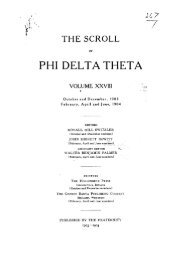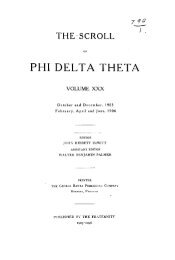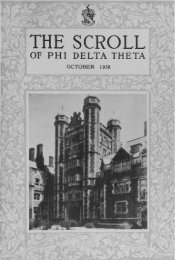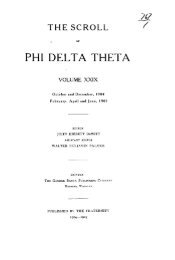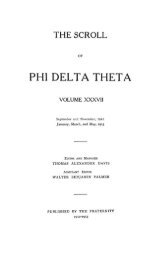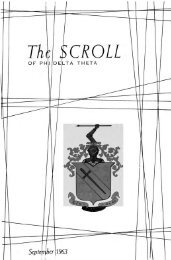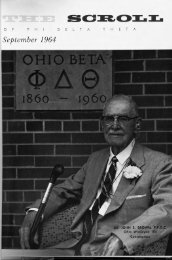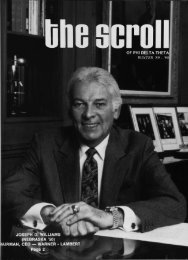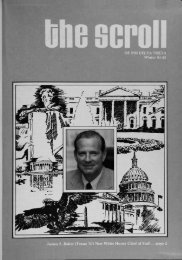- Page 1:
THE SCROLLPHI DELTA THETAEditorGEOR
- Page 6 and 7:
The Fortieth General Convention531
- Page 8 and 9:
THE SCROLLPHI DELTA THETA October,
- Page 10 and 11:
THE SCROLLPHI DELTA THETA October,
- Page 12 and 13:
THE SCROLLPHI DELTA THETANo detail
- Page 14 and 15:
New Member of theGeneral CouncilI N
- Page 16:
THE SCROLLPHI DELTA THETA October,
- Page 19 and 20:
THE SCROLLVol. LV, No. 1 PHI DELTA
- Page 21 and 22:
THE SCROLLVol. LV, No. 1 PHI DELTA
- Page 23 and 24:
THE SCROLLVol. LV, No. 1 PHI DELTA
- Page 25:
Installation of Alberta AlphaByARCH
- Page 28 and 29:
MEDICAL BUILDING, UNIVERSITY OF ALB
- Page 30 and 31:
INSTALLATION PARTY, MANITOBA ALPHA,
- Page 32 and 33:
CHAPTER HOUSE, MANITOBA ALPHA, UNIV
- Page 34 and 35:
THE SCROLLPHI DELTA THETA October,
- Page 36 and 37:
Magistrate of the City of New YorkO
- Page 38 and 39:
PAUL JESSUP, Washington, '30World's
- Page 40 and 41:
Phi Leaders in the Professional Wor
- Page 42 and 43:
THE SCROLLPHI DELTA THETA October,
- Page 44 and 45:
THE SCROLLPHI DELTA THETA October,
- Page 46 and 47:
THE SCROLLPHI DELTA THETA October,
- Page 48 and 49:
Al umniRussell W. Van Kirk, Arizona
- Page 50 and 51:
THE SCROLLPHI DELTA THETA October,
- Page 52 and 53:
THE SCROLLPHI DELTA THETA October,
- Page 54 and 55:
Chapter GrandLeonard Beall, Idaho,
- Page 56 and 57:
THE SCROLLPHI DELTA THETA October,
- Page 58 and 59:
THE SCROLLPHI DELTA THETA October,
- Page 60 and 61:
THE SCROLLPHI DELTA THETA October,
- Page 62 and 63:
THE SCROLLPHI DELTA THETA October,
- Page 64 and 65:
Chapter LettersAlabama Alpha, Unive
- Page 66 and 67:
THE SCROLLPHI DELTA THETA October,
- Page 68 and 69:
THE SCROLLPHI DELTA THETA October,
- Page 70 and 71:
THE SCROLLPHI DELTA THETA October,
- Page 72 and 73:
THE SCROLLPHI DELTA THETA October,
- Page 74 and 75:
THE SCROLLPHI DELTA THETA October,
- Page 76 and 77:
THE SCROLLPHI DELTA THETA October,
- Page 78 and 79:
THE SCROLLPHI DELTA THETA October,
- Page 80 and 81:
THE SCROLLPHI DELTA THETA October,
- Page 82 and 83:
THE SCROLLPHI DELTA THETA October,
- Page 84 and 85:
THE SCROLLPHI DELTA THETA October,
- Page 86 and 87:
THE SCROLLPHI DELTA THETA October,
- Page 88 and 89:
THE SCROLLPHI DELTA THETA October,
- Page 90 and 91:
THE SCROLLPHI DELTA THETA October,
- Page 92 and 93:
THE SCROLLPHI DELTA THETA October,
- Page 94 and 95:
THE SCROLLPHI DELTA THETA October,
- Page 96 and 97:
THE SCROLLPHI DELTA THETA October,
- Page 98 and 99:
^t)e goober Sc^mitf) Co.712 CHESTNU
- Page 100 and 101:
^3 u Co.9 ijgZ OcgaSallys„n =fl
- Page 103 and 104:
New Chapter House of Oregon Beta,Or
- Page 105 and 106:
Phi Leaders in the Professional Wor
- Page 107 and 108:
Vol. LV, No. 2to the Confederate co
- Page 109 and 110:
Vol. LV, No. 2THE SCROLLPHI DELTA T
- Page 111 and 112:
Chapter GrandHumphrey Robinson Keeb
- Page 113 and 114:
Al umniWilliam H. Greenleaf, North
- Page 115 and 116:
Vol. LV, No. 2university and is the
- Page 117 and 118:
Vol. LV, No. 2THE SCROLLPHI DELTA T
- Page 119 and 120:
Chapter News in BriefAlabama Alpha,
- Page 121 and 122:
VoL LV, No. 2THE SCROLLPHI DELTA TH
- Page 123 and 124:
Vol. LV, No. 2THE SCROLLPHI DELTA T
- Page 125 and 126:
Vol. LV, No. 2THE SCROLLPHI DELTA T
- Page 127 and 128:
Vol. LV, No. 2THE SCROLLPHI DELTA T
- Page 129 and 130:
Vol. LV, No. 2THE SCROLLPHI DELTA T
- Page 131 and 132:
Vol. LV, No. 2THE SCROLLPHI DELTA T
- Page 133 and 134:
Vol. LV, No. 2THE SCROLLPHI DELTA T
- Page 135 and 136:
Vol. LV, No. 2THE SCROLLPHI DELTA T
- Page 137 and 138:
Vol. LV, No. 2THE SCROLLPHI DELTA T
- Page 139 and 140:
VoL LV, No. 2THE SCROLLPHI DELTA TH
- Page 141 and 142:
Vol. LV, No. 2THE SCROLLPHI DELTA T
- Page 143 and 144:
Vol. LV, No. 2THE SCROLLPHI DELTA T
- Page 145 and 146:
Vol. LV, No. 2THE SCROLLPHI DELTA T
- Page 147 and 148:
Vol LV, No. 2THE SCROLLPHI DELTA TH
- Page 149 and 150:
VoL LV, No. 2THE SCROLLPHI DELTA TH
- Page 151 and 152:
VoL LV, No. 2THE SCROLLPHI DELTA TH
- Page 153 and 154:
VoL LV, No. 2THE SCROLLPHI DELTA TH
- Page 155 and 156:
VoL LV, No. 2THE SCROLLPHI DELTA TH
- Page 157 and 158:
VoL LV, No. 2THE SCROLLPHI DELTA TH
- Page 159 and 160:
VoL LV, No. 2Fletcher is now second
- Page 161 and 162:
THE SCROLLVol. LV, No. 2 PHI DELTA
- Page 163 and 164:
VoL LV, No. 2THE SCROLLPHI DELTA TH
- Page 165 and 166:
VoL LV, No. 2THE SCROLLPHI DELTA TH
- Page 167 and 168:
VoL LV, No. 2THE SCROLLPHI DELTA TH
- Page 169 and 170:
Vol. LV, No. 2First Monday each mon
- Page 171 and 172:
THE SCROLLP H I D E LTA THETAGEORGE
- Page 173 and 174:
VOLUMELV rHE SCROLL ^^^^""^''°-' P
- Page 175 and 176:
British Columbia AlphaUniversity of
- Page 177 and 178:
Vol. LV, No. 3THE SCROLLPHI DELTA T
- Page 179 and 180:
Vol. LV, No. 3THE SCROLLPHI DELTA T
- Page 181 and 182:
Vol. Ll\ No. 3THE SCROLLPHI DELTA T
- Page 183 and 184:
New Governor of" MassachusettsIs a
- Page 185 and 186:
A Business AnalystWith the Departme
- Page 187 and 188:
Japanese Magnate Visits Philadelphi
- Page 189 and 190:
Al umni* A 0 had the largest repres
- Page 191 and 192:
Vol. LV, No. 3THESCROLLPHI DELTA TH
- Page 193 and 194:
Vol. LV, No. 3THE SCROLLPHI DELTA T
- Page 195 and 196:
Vol. LV, No. 3Rowe as a result of a
- Page 197 and 198:
Chapter News in BriefAlberta Alpha,
- Page 199 and 200:
Vol. LV, No. 3THE SCROLLPHI DELTA T
- Page 201 and 202:
Vol. LV, No. 3THE SCROLLPHI DELTA T
- Page 203 and 204:
VoL LV, No. 3THE SCROL[.PHI DELTA T
- Page 205 and 206:
VoL LV, No. 3THE SCROLLPHI DELTA TH
- Page 207 and 208:
VoL LV, No. 3THE SCROLLPHI DELTA TH
- Page 209 and 210:
VoL LV, No. 3THE SCROLLPHI DELTA TH
- Page 211 and 212:
VoL LV, No. 3THE SCROLLPHI DELTA TH
- Page 213 and 214:
VoL LV, No. 3THE SCROLLPHI DELTA TH
- Page 215 and 216:
VoL LV, No. 3THE SCROLLPHI DELTA TH
- Page 217 and 218:
VoL LV, No. 3THE SCROLLPHI DELTA TH
- Page 219 and 220:
VoL LV, No. 3THE SCROLLPHI DELTA TH
- Page 221 and 222:
VoL LV, No. 3THE SCROLLPHI DELTA TH
- Page 223 and 224:
VoL LV, No. 3THIi SCROLLPHI DELTA T
- Page 225 and 226:
VoL LV, No. 3Social Activities: A f
- Page 227 and 228:
VoL LV, No. 3THE SCROLLPHI DELTA TH
- Page 229 and 230:
VoL LV, No. 3THE SCROLLPHI DELTA TH
- Page 231 and 232:
VoL LJ\ No. 3THE SCROLLPHI DELTA TH
- Page 233 and 234:
Vol. LV, No. 3First Monday each mon
- Page 235 and 236:
THE SCROLLPHI DELTA THETAEditorGEOR
- Page 237 and 238:
VOLUME LV I I 11 ^t Ixv vl I JANUAR
- Page 239 and 240:
Phi Delta Theta in Football, 1930FI
- Page 241 and 242:
GRIFFTH, Tackle, OhioBAKER, Quarter
- Page 243 and 244:
TONKIN, QuarterbackWashington State
- Page 245 and 246:
GARRITY. Fullback, CaliforniaCONOVE
- Page 247 and 248:
Vol. LV, No. 4outstanding generalsh
- Page 249:
FOR A NEW CHAPTER, ALBERTA ALPHA DO
- Page 252 and 253:
THE SCROLLPHI DELTA THETA January,
- Page 254 and 255:
THE SCROLLPHI DELTA THETA January,
- Page 258 and 259:
LOUNGF,, MARYLAND ALPHA'S CHAPTER H
- Page 260 and 261:
THE SCROLLPHI DELTA THETA January,
- Page 262 and 263:
THE SCROLLPHI DELTA THETAin the Wes
- Page 264 and 265:
THE SCROLLPHI DELTA THETA January,
- Page 266 and 267:
Pennsylvania Epsilon Has Beenat Dic
- Page 268 and 269:
Phi Appointed Federal JudgeI HE cit
- Page 270 and 271:
THE SCROLLPHI DELTA THETA January,
- Page 272 and 273:
THE SCROLLPHI DELTA THETAJanuary, 1
- Page 274 and 275:
THE SCROLLPHI DELTA THETAleading Br
- Page 276 and 277:
Phis of PhiladelphiaBy RUSSELL H. F
- Page 278 and 279:
Al umniDr. Stuart Pritchard, Toront
- Page 280 and 281:
THESCROLLPHI DELTA THETAJanuary, 19
- Page 282 and 283:
THESCROLLPHI DELTA THETAJanuary, 19
- Page 284 and 285:
Undergraduates of AchievementbviN p
- Page 286 and 287:
THE SCROLLPHI DELTA THETA January,
- Page 288 and 289:
THESCROLLPHI DELTA THETAJanuary, 19
- Page 290 and 291:
Chapter News in BriefAlabama Alpha,
- Page 292 and 293:
THE SCROLLPHI DELTA THETAJanuary, 1
- Page 294 and 295:
THE SCROLLPHI DELTA THETA January,
- Page 296 and 297:
THE SCROLLPHI DELTA THETA January,
- Page 298 and 299:
THE SCROLLPHI DELTA THETA January,
- Page 300 and 301:
THE SCROLLPHI DELTA THETA January,
- Page 302 and 303:
THE SCROLLPHI DELTA THETA January,
- Page 304 and 305:
THE SCROLLPHI DELTA THETA January,
- Page 306 and 307:
THE SCROLLPHI DELTA THETAJanuary, 1
- Page 308 and 309:
THE SCROLLPHI DELTA THETA January,
- Page 310 and 311:
THE SCROLLPHI DELTA THETA January,
- Page 312 and 313:
THE SCROLLPHI DELTA THETAJanuary, 1
- Page 314 and 315:
THE SCROLLPHI DELTA THETA January,
- Page 316 and 317: THE SCROLLPHI DELTA THETAJanuary, 1
- Page 318 and 319: THE SCROLLPHI DELTA THETA January,
- Page 320 and 321: Alumni ClubsBaltimore, MarylandThe
- Page 322 and 323: THE SCROLLPHI DELTA THETA January,
- Page 324 and 325: THE SCROLLPHI DELTA THETA January,
- Page 326 and 327: THE SCROLLPHI DELTA THETA January,
- Page 328 and 329: THE SCROLLPHI DELTA THETA January,
- Page 330 and 331: ^mitl) Co.712 CHESTNUT STREETPHILAD
- Page 333: VOLUME LV | | 1 [- ^ ^^ |^ K ) |_ |
- Page 336 and 337: Two More Phi Rhodes Scholars . .Swa
- Page 338 and 339: THE SCROLLPHI DELTA THETA February,
- Page 340 and 341: THESCROLLPHI DELTA THETALeonard Bow
- Page 342 and 343: THE SCROLLPHI DELTA THETAFebruary,
- Page 344 and 345: THESCROLLPHI DELTA THETARandolph-Ma
- Page 346 and 347: THE SCROLLPHI DELTA THETA February,
- Page 348 and 349: THE SCROLLPHI DELTA THETA February,
- Page 350 and 351: Chapter Grand . .James R. Noland, W
- Page 352 and 353: THESCROLLPHI DELTA THETAFebruary, 1
- Page 354 and 355: Alumni ClubsPhiladelphia, Pennsylva
- Page 356 and 357: THE SCROLLPHI DELTA THETA February,
- Page 358 and 359: THE SCROLLPHI DELTA THETA February,
- Page 360 and 361: THE SCROLLPHI DELTA THETA February,
- Page 362 and 363: ^mitf) Co.712 CHESTNUT STREETPHILAD
- Page 365: VOLUME LV JHE SCROLL ^'''""''"'•'
- Page 369 and 370: Vol. LV, No. 6THE SCROLLPHI DELTA T
- Page 371 and 372: Vol. LV, No. 6THESCROLLPHI DELTA TH
- Page 373: Vol. LV, No. 6THE SCROLLPHI DELTA T
- Page 376 and 377: FORMERHOMEOF MICHIGAN BETAMICHIGAN
- Page 378 and 379: THE SCROLLPHI DELTA THETA March, 19
- Page 380 and 381: MEDICAL COLLEGE ATSOUTH CAROLINADAV
- Page 382 and 383: THE SCROLLPHI DELTA THETA March, 19
- Page 384 and 385: THE SCROLLPHI DELTA THETA March, 19
- Page 386 and 387: INDIANA DELTA'S CHRISTMAS PARTY FOR
- Page 388 and 389: THE SCROLLPHI DELTA THETAreached se
- Page 390 and 391: FRED J. MILLIGAN, Ohio State, '28As
- Page 392 and 393: DR. JOHN LEE COULTER, North Dakota,
- Page 394 and 395: Memorial to Guy Potter BentonBy ART
- Page 396 and 397: THE SCROLLPHI DELTA THETA March, 19
- Page 398 and 399: THE SCROLLPHI DELTA THETA March, 19
- Page 400 and 401: THESCROLLPHI DELTA THETAresearch co
- Page 402 and 403: THE SCROLLPHI DELTA THETA March, 19
- Page 404 and 405: f — — •San Francisco Personal
- Page 406 and 407: THE SCROLLPHI DELTA THETA March, 19
- Page 408 and 409: THE SCROLLPHI DELTA THETA March, 19
- Page 410 and 411: THE SCROLLPHI DELTA THETA March, 19
- Page 412 and 413: THE SCROLLPHI DELTA THETA March, 19
- Page 414 and 415: Chapter News in BriefAlabama Alpha,
- Page 416 and 417:
THE SCROLLPHI DELTA THETAMarch, 193
- Page 418 and 419:
THE SCROLLPHI DELTA THETA March, 19
- Page 420 and 421:
THE SCROLLPHI DELTA THETA March, 19
- Page 422 and 423:
THE SCROLLPHI DELTA THETA March, 19
- Page 424 and 425:
THE SCROLLFHI DELTA THETA March, 19
- Page 426 and 427:
THE SCROLLPHI DELTA THETA March, 19
- Page 428 and 429:
THE SCROLLPHI DELTA THETAMarch, 193
- Page 430 and 431:
THE SCROLLPHI DELTA THETA March, 19
- Page 432 and 433:
THE SCROLLPHI DELTA THETA March, 19
- Page 434 and 435:
THE SCROLLPHI DELTA THETA March, 19
- Page 436 and 437:
THE SCROLLPHI DELTA THETA March, 19
- Page 438 and 439:
THE SCROLLPHI DELTA THETA March, 19
- Page 440 and 441:
THE SCROLLPHI DELTA THETA March, 19
- Page 442 and 443:
THE SCROLLPHI DELTA THETA March, 19
- Page 444 and 445:
THE SCROLLPHI DELTA THETA March, 19
- Page 446 and 447:
THE SCROLLPHI DELTA THETA March, 19
- Page 448 and 449:
THE SCROLLPHI DELTA THETA March, 19
- Page 450 and 451:
THE SCROLLPHI DELTA THETA March, 19
- Page 452 and 453:
THE SCROLLPHI DELTA THETA March, 19
- Page 454 and 455:
THE SCROLLPHI DELTA THETA March, 19
- Page 456 and 457:
THE SCROLLPHI DELTA THETA March, 19
- Page 458 and 459:
tKfie goober Sc^mitf) Co.712 CHESTN
- Page 460 and 461:
H c§ £ g"Eii:_£_-y.^ 0•ai-,f^'
- Page 462 and 463:
OKLAHOMA ALPHA'S BASKETBALL TEAM, 1
- Page 464 and 465:
Babe Kamp, Illinois,ForwardBishop,
- Page 466 and 467:
W. Rohlffs, Montana,ForwardAdkins,
- Page 468 and 469:
^^^^i^ • ^ " ^ ^^yLicht, Minnesot
- Page 470 and 471:
f^ 1J lA^l Ir 1[f»^t^g H^HMINNESOT
- Page 472 and 473:
THE SCROLLPHI DELTA THETA April, 19
- Page 474 and 475:
THE SCROLLPHI DELTA THETA April, 19
- Page 476 and 477:
THE SCROLLPHI DELTA THETAwould do c
- Page 478 and 479:
Chapter Grandfulius Earl Waller, Wi
- Page 480 and 481:
THE SCROLLPHI DELTA THETACharles Ne
- Page 482 and 483:
THE SCROLLPHI DELTA THETA April, 19
- Page 484 and 485:
THE SCROLLPHI DELTA THETA April, 19
- Page 486 and 487:
THE SCROLLPHI DELTA THETA April, 19
- Page 488 and 489:
THE SCROLLPHI DELTA THETA April, 19
- Page 490 and 491:
^mitfi Co.712 CHESTNUT STREETPHILAD
- Page 493 and 494:
VOLUMELV THE SCROLL ^^^PHI DELTA TH
- Page 495 and 496:
Phi Receives Knute Rockne's MantkBy
- Page 497 and 498:
Interesting Old Chapter PictureUnea
- Page 499 and 500:
South Dakota Phi, 37 Years OldAppoi
- Page 501 and 502:
Al umniJohn Harold Wittner, Union,
- Page 503 and 504:
Vol. LV, No. 8THE SCROLLPHI DELTA T
- Page 505 and 506:
Undergraduates of AchievementKennet
- Page 507 and 508:
Chapter Grand . . .Samuel A. W. Car
- Page 509 and 510:
Vol. LV, No. 8THE SCROLLPHI DELTA T
- Page 511 and 512:
Vol. LV, No. 8THE SCROLLPHI DELTA T
- Page 513 and 514:
VoL LV, No. 8THE SCROLLPHI DELTA TH
- Page 515 and 516:
Vol. LV, No. 8THE SCROLLPHI DELTA T
- Page 517 and 518:
Vol. LV, No. 8THE SCROLLPHI DELTA T
- Page 519 and 520:
Vol. LV, No. 8THE SCROLLPHI DELTA T
- Page 521 and 522:
Vol. LV, No. 8THE SCROLLPHI DELTA T
- Page 523 and 524:
VoL LV, No. 8this season. The annua
- Page 525 and 526:
VoL LV, No. 8THE SCROLLPHI DELTA TH
- Page 527 and 528:
Vol LV, No. 8THE SCROLLPHI DELTA TH
- Page 529 and 530:
VoL LV, No. 8THE SCROLLPHI DELTA TH
- Page 531 and 532:
Vol. LV, No. 8THE SCROLLPHI DELTA T
- Page 533 and 534:
VoL LV, No. 8THE SCROLLPHI DELTA TH
- Page 535 and 536:
VoL LV, No. 8THE SCROLLPHI DELTA TH
- Page 537 and 538:
VoL LV, No. 8THE SCROLLPHI DELTA TH
- Page 539 and 540:
VoL LV, No. 8THE SCROLLPHI DELTA TH
- Page 541 and 542:
VoL LV, No. 8THE SCROLLPHI DELTA TH
- Page 543 and 544:
VoL LV, No. 8THE SCROLLPHI DELTA TH
- Page 545 and 546:
Alumni ClubsBaltimore, MarylandBrot
- Page 547 and 548:
DirectoryTHE PHI DELTA THETA FRATER
- Page 549 and 550:
VoL LV, No. 8THE SCROLLPHI DELTA TH
- Page 551 and 552:
VoL LV, No. 8PENNSYLVANIA ETA (1886
- Page 553 and 554:
VoL LV, No. 8THE SCROLLPHI DELTA TH



